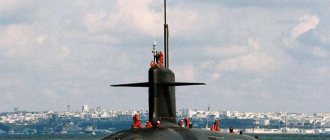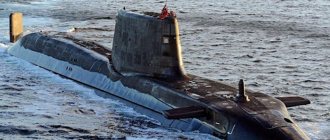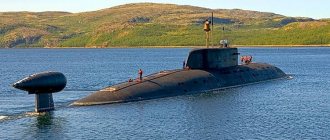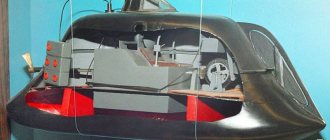Flagship of the Israeli Navy
Israeli sailors always remain in the shadow of their more successful colleagues from the Air Force and Ground Forces. A tiny country smaller than the Moscow region, by definition, cannot have a strong ocean-going fleet, and the main event that glorified the Israeli Navy throughout the world - the sinking of the destroyer Eilat - did not add prestige to this type of armed forces. Meanwhile, the specifics of the Arab-Israeli conflicts often required support for land operations from the sea. The Israeli Navy, despite its small numbers and the absence of large ships, took part in many naval battles, exercised control over sea communications throughout the eastern Mediterranean Sea, and participated in landings and naval sabotage.
Israeli sailors cannot control the situation in the South Atlantic or monitor the ships of a “potential enemy” in the Pacific Ocean, but, unlike the fleets of major maritime powers, the Israeli Navy is an active fleet that regularly participates in combat operations. In addition to the death of the Eilat, there are other noteworthy events in the history of the Israeli Navy, for example, the destruction of the flagship of the Egyptian Navy, Emir Farouk, blown up by combat swimmers in the Tel Aviv roadstead. Or the Battle of Latakia (1973) - the world's first naval battle of missile boats.
A 45-year-long mystery
When talking about the Israeli Navy, it is definitely worth mentioning a special incident that took place off the coast of the state of Israel during the Six-Day War. On June 8, 1967, the USS Liberty bobbed gently on the waves 12 miles offshore, its off-duty crew members slathered in sunscreen and sunbathing in the warm Mediterranean sun. I couldn’t even believe that at that time there were fierce tank battles going on on the shore in the desert. But the American sailors felt completely safe: after all, America and Israel are allies - what problems could there be?
A paranormal thing happened: Mirages with six-rayed stars on their wings suddenly appeared above the Liberty, and fire descended from the sky onto the American reconnaissance ship. The planes shot down the Liberty's superstructure with 30 mm cannons, and then filled the ship with napalm. At the same moment, the torpedo boats of the Israeli Navy launched an attack - a deafening explosion literally threw the Liberty out of the water. Having received a hole in the underwater part, the ship began to collapse on the starboard side. The nightmare did not end there - the Israelis came closer and began point-blank with small arms to shoot people rushing around the burning deck of the Liberty. Of the 290 American reconnaissance crew, Israeli sailors and pilots killed and wounded 205 people. And an hour later... Israeli torpedo boats approached the Liberty again, this time saying: “Do you need help?” In response, they shouted from the crippled ship: “Get the hell out!”
The next day, all the details of the incident were classified on both sides, Israel whispered words of apology and secretly paid 13 million dollars in compensation (in 1967 prices). It is still not clear what it was. The official version is only suitable for the younger group of kindergarten - you see, the Israeli military confused the Liberty, richly decorated with the stars and stripes and with a huge parabolic antenna (displacement - 10,000 tons), with the Egyptian horse transport Al-Quseir (displacement - 2600 tons).
The circumstances of the tragedy are stubbornly hushed up, but the most likely is the “Golan version”: knowing how the American National Security Agency works [2]
(“Liberty” de facto belonged to the NSA), the Israeli General Staff feared that the secret details of the planned operation to capture the Golan Heights would be intercepted by Liberty’s powerful radio equipment, and would inevitably, through Soviet agents in the NSA, become known to the Arabs at the same hour. The consequence will be a bloody mess of advancing Israeli units. In addition, there was a stream of other “unprintable” orders on the radio, for example, about the execution of 1 thousand captured Egyptian soldiers in the town of El-Atshsh in the Sinai. The Israelis were extremely unwilling to give international publicity to such facts and immediately put Liberty to use. Experienced diplomats will somehow come to an agreement...
"Eilat" class
But we have not gathered here to remember the dark sides of the twentieth century. The fact is that the Israeli Navy, in addition to numerous boats and several diesel submarines, has, in my opinion, very interesting naval assets. These are corvettes of the Saar 5 type - a series of three multi-purpose ships with a total displacement of 1250 tons. "Eilat", "Lahav" and "Hanit". The corvettes were designed by Israeli specialists specifically taking into account the conditions of the Middle East conflict. They were built between 1992 and 1995 at the American shipyard Ingalls Shipbuilding.
INS Eilat
Having studied the experience of other maritime powers, the Israeli Navy chose the development concept of the USSR Navy for its ships. Those. saturate warships to the limit with firepower to the detriment of their cruising range. Ideal for short sea raids. The result was really good corvettes that acted as leaders in squadrons of missile boats and small artillery ships. Corvettes of the "Eilat" type (in honor of the lead ship of the series), despite their small size (displacement is 2 times less than the Russian corvette Project 20380 "Steregushchy"), significantly enhance the striking power of their mini-squadron and are capable of providing high-quality cover for small ships and boats from air attacks. Next is the list.
The main caliber of the Eilat is 8 Harpoon anti-ship missiles. A familiar thing, the most common subsonic anti-ship missile in the world. Flight range - 120...150 km (of course, in the absence of external target designation, the firing range automatically becomes equal to the radio horizon, i.e. 30...40 km). The warhead of the “Harpoon” is 225 kilograms, the marching speed is Mach 0.85. "Harpoon", with a successful combination of circumstances, is capable of stopping even a large destroyer-class target, but launching a missile costing $1.5 million at boats or other small-sized targets is too wasteful. The Israelis have also provided a special means for this option - the Gabriel anti-ship missile of their own production, and the corvettes are armed with its outdated version - Gabriel-2, which does not even have an active homing head. This significantly reduces the cost of the missile, and its natural disadvantages: the need to constantly turn on the ship's radar and the short flight range - only 35 kilometers - are absolutely not important when repelling attacks by armed terrorist boats.
In technical terms, the Gabriel is a subsonic single-stage cruise missile, similar in size to the Harpoon anti-ship missile. Starting weight – 600 kg. Flight speed to target - Mach 0.75. Semi-armor-piercing warhead weighing 150 kg. Suitable for shelling objects on the shore.
INS Lahav
Anti-aircraft weapons: Israeli engineers take air defense very seriously. The Eilat-class corvettes are equipped with the latest Israeli anti-aircraft missile system "Barak-1" (translated from Hebrew as "Molniya"). 64 vertical launch cells, the anti-aircraft missile of the complex hits targets within a radius of 12 km from the ship, the maximum interception altitude is 5 km. The new EL/M-2248 radar with fixed antenna arrays is capable of detecting any air threats, including low-flying cruise missiles and guided bombs. Despite the fact that Barak-1 is very expensive, it is a popular anti-aircraft missile system on the world market; "Barak-1" has been adopted by the navies of India, Singapore, Venezuela, Azerbaijan and other countries. Together with India, Israel is developing a new modification of its naval air defense system, capable of hitting targets at a range of 70 km. In addition, the Phalanx anti-aircraft complex is installed on the bow of the corvette - a six-barreled automatic cannon of 20 mm caliber, articulated on a single carriage with an sighting system and radar.
Torpedo-mine weapons: To counter possible attacks from submarines, Eilat-class corvettes are armed with two standard torpedo tubes for launching Mark-32 anti-submarine torpedoes, standard for NATO navies.
Aviation weapons: On the small ship there was even room for permanent deployment of a helicopter; there is a helipad and a hangar for storing equipment. The multi-purpose Eurocopter Panther helicopter has been selected for deployment on the deck of Israeli corvettes.
Electronic warfare: Given the experience of the Yom Kippur War, when, thanks to the use of the latest electronic warfare systems, not a single one of the 54 P-15 Termit missiles fired from ships of the Syrian and Egyptian Navy reached the target, Israeli sailors attach particular importance to electronic warfare systems. The ship's armament complex includes: - three launchers for shooting Elbit Deseaver dipoles - Rafael Wizard anti-radar jammer (wideband zapping anti-radar decoy) with passive corner reflectors - radar warning system "Elisra NS-9003/9005" - system anti-torpedo protection AN/SLQ-25 Nixie, consisting of an on-board signal generator and a towed hydroacoustic jammer.
INS Hanit
Powerful, but... On July 14, 2006, during the Lebanon War, the Israeli Navy corvette Hanit came under a missile attack from the shore. No advanced anti-aircraft systems or jamming systems saved the Hanit: a 700-kilogram Chinese-made YJ-82 anti-ship missile [3]
struck the side of the ship, killing 4 Israeli sailors. This time, the Israeli Navy was relatively lucky: despite the detonation of the 165 kg missile warhead, the corvette remained afloat and did not receive serious damage. Six months later, Hanit was able to return to combat missions off the coast of Lebanon.
The cause of the incident was ordinary human negligence - at the time of the missile attack, the corvette's tracking systems were inoperative. The crew did not expect the enemy to have powerful anti-ship missiles and at that moment were solving some of their own problems. By the way, a quarter of a century before these events, a disabled radar caused the death of the British destroyer Sheffield. History teaches no one.
General characteristics of the Eilat-class corvette: Length along the vertical line - 85.6 meters, width -11.88 meters, draft - 3 meters. The case is made taking into account the requirements of stealth technology. Standard displacement is 1000 tons. Total displacement - 1250 tons. Crew – 74 people. The ship is powered by a combination plant consisting of two V12 diesel engines and a General Electric LM2500 gas turbine for full propulsion. Full speed – 33 knots Cruising range on economic speed – 3500 nautical miles (distance by sea from St. Petersburg to Murmansk).
You shouldn't be surprised. how Israeli engineers managed to place so many weapons systems on such a miniature corvette and provide the ship with high seaworthiness. Back in 1967, a project for a small missile ship was created in the Soviet Union according to a project with an easy-to-remember code 1234. In the hull of the MKR with a total displacement of 730 tons (!) it was possible to place 6 launchers for launching heavy anti-ship missiles P-120 “Malachite”, a double-boom launcher installation of the Osa air defense system (20 missiles), as well as a 76 mm universal cannon and a 30 mm AK-630 anti-aircraft gun. Of course, there was no aviation on board, but look at the year the ship was created. In those days, a helicopter seemed overkill. Small missile ships, Project 1234, were built in batches in the USSR and still remain in service in many countries around the world. It was the Mirage MRK that distinguished itself in a missile battle in the Black Sea in August 2008.
As for the Saar-5 (Eilat) type corvettes, until a new warship project with the Aegis system is created, corvettes of this type remain the flagship ships of the Israeli Navy.
Notes. 1. The destroyer "Eilat" is a former British Z-class destroyer. The laying date is 1943, the total displacement is 1700 tons. Sunk in 1967 by four P-15 Termit anti-ship missiles fired from Egyptian missile boats. The date of the destruction of the destroyer, October 21, is celebrated as Israeli Navy Day. 2. In the USA there are 25 intelligence services of various profiles: FBI, CIA, NSA, ONI naval intelligence, etc., etc. 3. Yingji YJ-82 anti-ship cruise missile manufactured in China, export designation C-802. Firing range – 120 km. (for some versions it can be increased to 500 km). RCC speed – 0.9M. Warhead weight – 165 kg. Equipped with an active radar homing head. Due to its low price, the rocket is extremely popular in developing countries.
Insignia
Admirals and officers
| Categories[2] | Admirals | Senior officers | Junior officers | ||||||
| Israeli rank | Aluf | Tat Aluf | Aluf Mishne | Sgan Aluf | Rav Seren | Seren | Segen | Segen mishneh | |
| Russian compliance | Rear Admiral | No | Captain 1st rank | Captain 2nd rank | Captain 3rd rank | Lieutenant Commander | Senior Lieutenant | Lieutenant | |
Sub-officers and sailors
| Categories | Sub-officers | Sergeants and petty officers | Sailors | ||||||
| Israeli rank | Rav Smal Bakhir | Rav Samal Mitkadem | Rav Samal Rishon | Rav Samal | Samal Rishon | Samal | Rav Torai | Torai Rishon | Torai |
| Russian compliance | Senior Warrant Officer | Ensign | No | Sergeant Major | Staff Sergeant | Sergeant | Lance Sergeant | Corporal | Private |
Signs on hats
- Israel Navy emblem.png
General sign
IDF structure
Today, the Israeli army is the main piece in a chess game that has been played in the Middle East for more than half a century. The entire Middle Eastern theater of operations is under the control of the IDF, given the increased military-technical capabilities of the army. During the peace period, the size of the army does not exceed 186 thousand people, of which 140 thousand are ground forces. In emergency situations, the army can rapidly increase its strength to 600 thousand people, most of whom will go to the disposal of ground army units.
Ground troops
The IDF structure includes:
- ground troops;
- Air Force (together with air defense forces);
- Naval Forces.
All three components of the IDF are under a single command. This is one of the main advantages that the Israeli army can boast over other armies. The main command and control of the troops comes from the Chief of the General Staff, who reports in turn to the Israeli Minister of Defense and the Prime Minister. The position of Chief of the General Staff is under the authority of the Knesset, the Israeli parliament, and is appointed by the country's government. Typically, tenure is limited to three years. In a number of cases, the tenure of the Chief of the General Staff is extended for another year, until the end of the powers of the current government.
Reserve
The entire territory of the country is divided into three operational districts - the northern, central and southern military districts. During military operations, district headquarters automatically become front headquarters. The basic tactical unit of the Israeli army is the division. Each division in the ground forces is a small army with its own strike units, logistics support, front-line aviation and air defense forces. When conducting large-scale military operations, a corps command is formed on the basis of the headquarters command of the district, which includes several divisions.
Missile boat
The Navy consists of surface and submarine forces, which equally carry out their assigned combat missions. The main function of the Israeli Navy is to protect maritime borders and prevent the blockade of ports and naval bases by potential enemy forces.
Elite pilots
The IDF Air Force represents the military elite. Pilots are only military personnel drafted into the army on a contract basis. Squadrons are formed by conscripts only for the needs of logistical and technical support for aviation units.
IV
The term “spear” has long been in use in European military literature - back at the beginning of the twentieth century, the requirements for the modernization of field artillery were formulated in exactly this way, and the range of the weapon was compared with the length of the spear.
With the “shield” it turned out a little differently - the invention of firearms deprived the value of knightly armor - but by the middle of the 19th century, when ships began to abandon sails and switch to steam, it turned out that the armor could be returned.
During the American Civil War, the world's first true battleship, the Monitor, was invented and built, the concepts of which - solid armor and rotating turrets - formed the basis for many other warship designs until World War II.
In addition to armor, one could escape from enemy artillery by throwing on an “invisibility cloak” - ships used smoke screens back in the First World War.
In World War II, the same idea was used to blind radar - the interference created by dropped strips of aluminum foil confused air defenses.
Approximately similar measures were used by the Israelis in the fall of 1973. What exactly was done and how - we do not know; the inventors of Israeli electronic curtains remain modestly silent on this matter.
But from the testimony of naval officers of their opponents, it is known that the marks on the radars suddenly began to multiply in the most strange way, and then either diverged in different directions, or even went into the sky.
Since it was difficult to hit such targets, the commanders of the Egyptian missile boats empirically came to use the following tactics: they fired a salvo at the maximum possible distance, then turned, and taking advantage of the fact that their ships were now as light as possible, they left at the maximum possible speed for the shore , hoping to be saved.
Some even succeeded.
I
In English-language military periodicals, materials began to appear related to Israel’s decision to expand the ship composition of the 3rd flotilla of the Israeli Navy, which includes surface missile-carrying ships[1].
This article is intended for Russian-speaking readers. Therefore, in case of difficulties associated with translation from Hebrew into English, and from English into Russian, we will use the same wording that is already used in reference literature in Russian - for example, in Wikipedia. So, on Wikipedia the 3rd flotilla is also called the “ missile boat flotilla”.
But what exactly is this - a missile boat?
Reasons for the high efficiency of the Israel Defense Forces
Analyzing the historical facts that indicate Israel’s activity in the political arena, one involuntarily comes to the conclusion that a strong and modern army is the key to a successful foreign policy of the state. Israel's military doctrine is defensive in nature. This is spelled out in the IDF charter, and IDF officers and soldiers are guided by this. The defensive policy of the Israeli State is fundamentally different from traditional tactical defense in the usual sense of the term.
IDF in Jerusalem
The actions of the armed forces, strategic planning and mobilization resources are aimed at conducting offensive operations. In other words, the Israeli army adheres to offensive tactics, acting within the framework of strategic defense. The reason why the country's leadership chose this tactic is simple to explain. A small territory with a complex configuration, Israel's geographical position does not have the capabilities to organize strategic defense to its full depth. The main weapon used by the Israelis during previous armed conflicts was to seize the strategic initiative. The army command has always sought to transfer combat operations to enemy territory, thereby protecting its own territory and population from destruction and suffering.
This tactic was repeatedly successfully demonstrated in all the wars that raged in the Middle East. Moreover, the surprising fact is that the IDF was opposed by numerous and well-armed armies of Arab states. The successful implementation of offensive defense was facilitated by the qualitative superiority of Israeli troops. This is not only technical equipment and competent, qualified command. The main factor in the IDF's high defensive capability is the high morale of its soldiers and high fighting spirit.
IDF soldiers
Israel has never been able to boast of large human resources that can be thoughtlessly thrown into the furnace of an armed conflict. In such a situation, the only correct decision was made - to have a small and technically trained professional army. The basis of the army is made up of regular military personnel and conscripts, who form the backbone of regular army units. The career military has a large mobilization reserve behind it, allowing it to triple or quadruple the size of the army in a matter of hours. Reservists for the Israeli army not only undergo training, but are also periodically called up for service. The Air Force and Navy have permanent personnel and numbers.
This structure for the formation of the armed forces has repeatedly proven its effectiveness, and this despite the fact that in Israel the army is recruited only on a conscription basis. Another distinctive feature of the Israeli military's recruitment system is the conscription of both men and women. Representatives of the fair sex can be found not only at communication centers and in headquarters offices. Women serve in combat units of the ground forces, serve in the navy and the air force. The ratio of girls to representatives of the stronger half in the Israeli army is 1 to 5.
Girls in ranks
In other words, the form in which the Israel Army exists today is due to the consequences of the geopolitical situation that has developed since the very first days of the existence of the State of Israel. Only this principle of building one’s own army, constantly improving weapons and maintaining troops in constant combat readiness, became the conditions and guarantees of the country’s survival.
IDF Army
VI
Let's start with boats: the Saar 4.5 project.
The first ships of this class were built in the 80s (see list). Full displacement - 498 tons.
Speed
: up to 34 knots.
Cruising range:
up to 4,800 nautical miles, or up to 8,900 km.
Crew
: 53 people.
Weapons:
4 anti-ship missiles of the “Gabriel” type; 4 anti-ship missiles of the “Harpoon” type; Artillery gun, different in different weapon variants; Two 20 mm. rapid-fire guns of the Oerlikon type; Two machine guns; A whole arsenal of all kinds of Israeli-made radars and electronic warfare equipment; Helicopter.
This is where it makes sense to pause.
Saar 4.5
Firstly, why does a missile boat need a helicopter? Its installation once set a world record - Saar 4.5
turned out to be the smallest of the warships of all countries in the world, which had its own aircraft.
Secondly, the cruising range. Is a warship capable of crossing the Atlantic more likely to belong not to the class of boats, but to the class of corvettes?
Let's put aside the answer to this question - we will deal with it later - but for now let's talk about the helicopter.
The answer to its necessity lies in the firing range of the missiles used by the Israelis. In the distant 70s, the Gabriel project had a destruction radius of two dozen kilometers, and at such a distance the boat had enough of its own target designation means.
But modern versions of this missile - “Gabriel-IV” and “Gabriel-V” / (Advanced Naval Attack Missile) - operate at distances that have not been publicly announced.
The same applies to the Harpoon missile supplied to Israel from the United States. In the 70s, its range was about 120 km - but about 40 years have passed since then, and its tactical and technical characteristics, of course, have changed.
Thus, it is clear that both the Gabriel and the Harpoon missiles require a target detection and tracking system that would be good to be raised higher than the ship’s mast and released for reconnaissance in any desired direction.
A helicopter is a means of such reconnaissance. Although now - let's note aside - it is increasingly being replaced by a drone.










